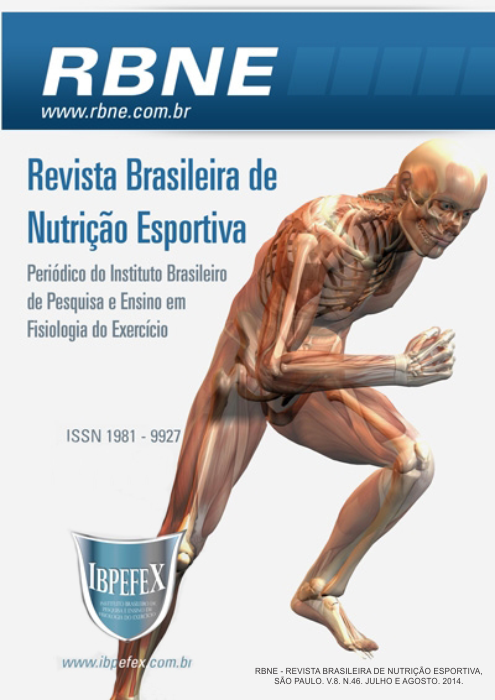Food antioxidants: consumption and knowledge among swimmers
Abstract
Swimming is a sport that brings organic and physical benefits to the body when practiced in moderation. The aim of this study was to evaluate the use of antioxidants and level of knowledge about its benefits in swimmers of both sexes, of Guarapuava -Paraná. For data collection questionnaires containing questions about the use of vitamin supplements, antioxidants, physical activity, level of knowledge about food sources of antioxidants were used, plus a frequency questionnaire of food consumption. Statistical analysis divided the participants into two groups A and B. A descriptive statistics, Fisher's exact test adopting a significance level of 5 % was used. It was observed that Group A has insufficient information on the mechanisms of action of antioxidants in the body, as well as its effects in preventing disease and premature aging, and about proper nutrition in health promotion.Regarding the frequency of consumption of antioxidant foods, most foods are not consumed daily, the group of vegetables only tomatoes in the fruit group appears to orange and apple on daily consumption, and the group of juices and beverages highlights tea. Therefore, it becomes evident the need to inform swimmers about a balanced diet that antioxidants are part of their daily lives.
References
-Barreiros, A.L.B.S.; e colaboradores. Estresse Oxidativo: Relação entre Geração de Espécies Reativas e Defesa do Organismo. Rev Quim. Nova. Vol. 29. Núm. 1. p. 113-123. 2006.
-Bianch, M.L.P.; Antunes, L.M.G. Radicais Livres e os Principais Antioxidantes da Dieta. Rev Nutr. Vol. 12. Núm. 2. p. 123-130. 1999.
-Carlsen, M.H.; e colaboradores. The total antioxidant content of more than 3100 foods, beverages, spices, herbs and supplements used worldwide. Nutr J. Vol. 9. Núm. 3. p. 2-11. 2010.
-Carvalho, T.; e colaboradores. Posição oficial da Sociedade Brasileira de Medicina do Esporte: atividade física e saúde. Vol.2. Núm. 4. p. 79-81. 1996.
-CBDA, Conselho Brasileiro Desportos Aquáticos. Disponível em <http://www.cbda.org.br/index.php>. Acesso em: 24/10/2010.
-Córdova, A.; Navas, F.L. Os radicais livres e o dano muscular produzido pelo exercício: papel dos antioxidantes. Rev Bras Med Esp. Vol. 6. Núm. 5. 204-208. 2000.
-Fanhani,A.P.G.;Ferreira,M.P. Agentes Antioxidantes: Seu Papel na Nutrição e Saúde dos Atletas. Rev Saúd e Bio. Vol. 1. Núm. 2. p. 33-41. 2006.
-Fonseca, A.B.P.B.L. Prática de atividade física e a formação de radicais livres. Rev. Nutr Saud & Perf. p. 45-46. 2004.
-Kabke, G.B.; Buchweitz, M.R.D.; Weymar, A. Avaliação Dietética dos Atletas de Natação no Período de Treinamento em Clube de Pelotas. In: I Amostra Cientifica.20-23 outubro. 2009.
-Lupulescu, A. The role of vitamins A, b-carotene, E and C in cancer cell biology. Int J Vitam Nutr Res. Vol. 63. Núm. 3. p. 3-14. 1993.
-Morais, S.M.; e colaboradores. Ação antioxidante de chás e condimentos de grande consumo no Brasil. Rev Bras Farm. Vol. 19. Núm. 1B. p. 315-320. 2009.
-Osawa, C.B.; Andries Júnior, O. Aspectos de saúde da equipe de natação da Unicamp. Rev Motriz. Vol. 12. Núm. 2. p. 149-158. 2006.
-Organização Mundial de Saúde. Obesity: preventing and managing the global epidemic. Report of a WHO consultation on obesity. Geneva. OMS. 1998.
-Ribeiro,K.S.; e colaboradores. Perfil Alimentar de Atletas Adolescentes Nadadores. Revista Brasileira de Nutrição Esportiva. Vol. 3. Núm.16. p. 331-339. 2009.
-Silva, L.A.; e colaboradores. Aspectos bioquímicos do exercício excêntrico e a suplementação de antioxidantes. Rev Mack de Educ Físc e Esp. Vol. 6. Núm. 1. p. 13-25. 2007.
-Sies,H. Strategies of antioxidant defence. Review. Eur J Biochem. Vol. 215. Núm. 2. p. 213-219. 1993.
-Satia, A.J.; Watters, J.L.; Galanko, J.A. Validation of an Antioxidant Nutrient Questionnaire in Whites and African Americans. J Am Diet Assoc. Vol. 109. p. 502-508. 2009.
-Telesi, M.; Machado, F.A.A. influência do exercício físico e dos sistemas antioxidantes na formação de radicais livres no organismo humano. Rev Saúd e Bio. Vol. 3. Núm. 1. p. 40-49. 2008.
-Vieira, S.; Freitas, A. O que é natação. Rio de Janeiro. Casa da Palavra, 2006.
-Vigario, O.S.; Oliveira, F.P. Composição Corporal de Nadadores Masters. Rev Eletr Esc Edu Fis. Desp. Vol. 2. Núm. 3. p. 21-35. 2006.
-WHO. Global strategy on diet, physical activity and health. Genebra. WHO. 2004.
-Zardo, D.M.; e colaboradores. Efeito no processamento do teor de compostos fenólicos e na atividade antioxidante em fermentados de maçã. Rev Sem Ciên Agrar. Vol. 30. Núm. 2. p. 361-370. 2009.
Authors who publish in this journal agree to the following terms:
- Authors retain the copyright and grant the journal the right of first publication, with work simultaneously licensed under the Creative Commons Attribution License BY-NC which allows the sharing of the work with acknowledgment of the authorship of the work and initial publication in this journal.
- Authors are authorized to enter into additional contracts separately for non-exclusive distribution of the version of the work published in this journal (eg, publishing in institutional repository or book chapter), with acknowledgment of authorship and initial publication in this journal.
- Authors are allowed and encouraged to post and distribute their work online (eg, in institutional repositories or on their personal page) at any point before or during the editorial process, as this can bring about productive change as well as increase impact and impact. citation of published work (See The Effect of Free Access).






